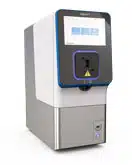Electroporation Essentials
Electroporation is a non-viral transfection method that applies an electric pulse to cells to cause transient permeability in the cell membrane. Diverse genetic engineering payloads such as DNA, mRNA, CRISPR, sgRNA and RNPs can travel through the membrane and enter the cell. Electroporation is a highly efficient delivery method that can be applied to a variety of cell types, from insect to mammalian.
How does electroporation work?
Electroporation is a straightforward process. Your cells and genetic engineering molecules of choice are suspended in a conductive solution and placed inside a processing assembly. Electrodes deliver an electric pulse across the solution following a protocol optimized for voltage and duration depending on cell type.

Optimizations & innovations
Numerous parameters can be optimized when performing electroporation to ensure high viability and efficient delivery. At MaxCyte® we have spent over 20 years refining our approach to electroporation and we would love to share what we’ve learned.

Buffer
Salts are commonly added to buffers to adjust conductivity. Osmolarity, however, affects cell membrane permeability and cell viability and must be adjusted by adding inert proteins or sugars.
At MaxCyte, we’ve taken the hard work out of buffer optimization by designing a solution that works with all cell types and is tailored to work with our instruments and protocols.
Electric pulse
Achieving successful transfection by applying an electric pulse requires precision. The strength, duration and number of pulses used to permeabilize membranes must be calibrated to the specific cell. That’s why MaxCyte has developed over 100 protocols for diverse cell types. With us, selecting the right electroporation protocol is as simple as the touch of a button.


Processing assemblies
An overlooked aspect of electroporation optimization is the design of the processing chamber. At MaxCyte we have developed specialized processing assemblies with inert materials to prevent biological and chemical contamination. Our electrodes are made of clinical-grade materials chosen to prevent toxic metal ions from forming in the cell suspension. Our processing assemblies ensure electroporation is gentle on cells without affecting phenotype and viability.
Partner with MaxCyte, the leader in electroporation
Our electroporation process was designed with the clinic in mind. As a result, we have expertise in optimizing every facet of electroporation. Our innovations bring you technology that is highly efficient and gentle, ensuring exceptional cell viability. MaxCyte electroporation enables a streamlined process for both transient and stable expression and is suited to a variety of applications.
Research applications
Resources
Electroporation systems
Supported by numerous publications and clinical trials, our ExPERT instruments are the next generation of the industry’s leading scalable electroporation technology.
Our instruments are capable of high-performance delivery of virtually any molecule, into any cell, at any scale with the unique ability to transfect primary cells, stem cells and cell lines with high cell viability and transfection efficiencies routinely over 90%.


Processing assemblies & reagents
MaxCyte’s consumable products provide users with a variety of options for project scale and throughput from discovery through GMP manufacturing using a single platform. Our range of processing assemblies allows users to transfect a variety of cell sample volumes to meet specific application needs. MaxCyte’s electroporation buffer is an animal-derived component free and safe for all cell types, ensuring consistent, high-performance transfection.








